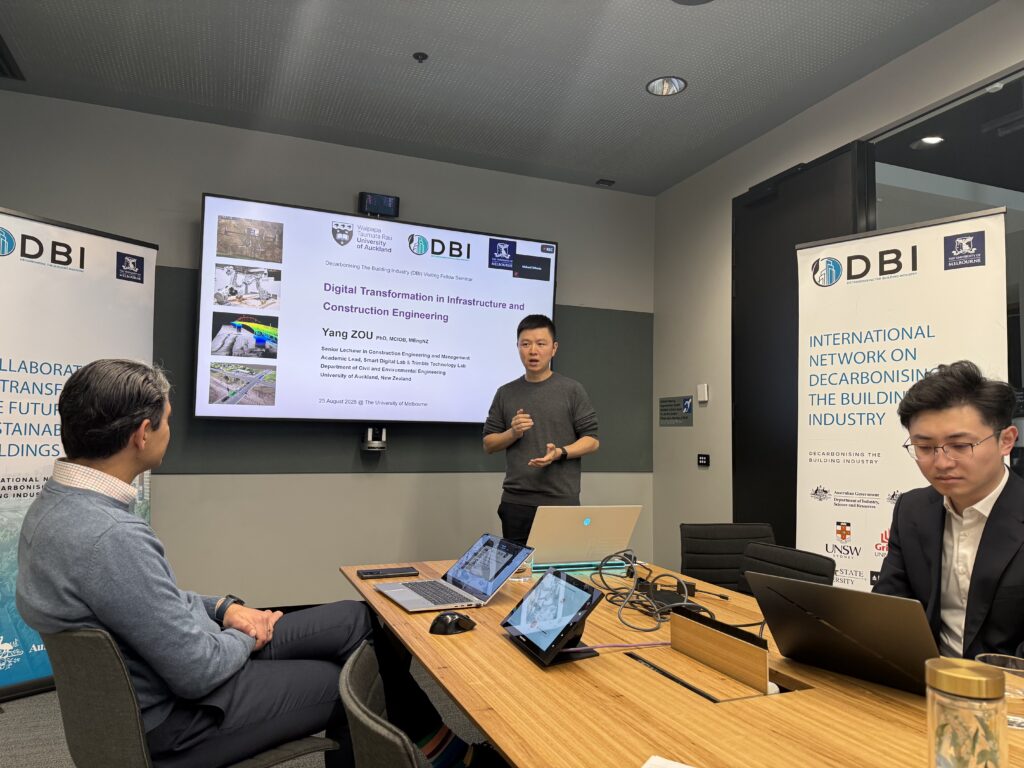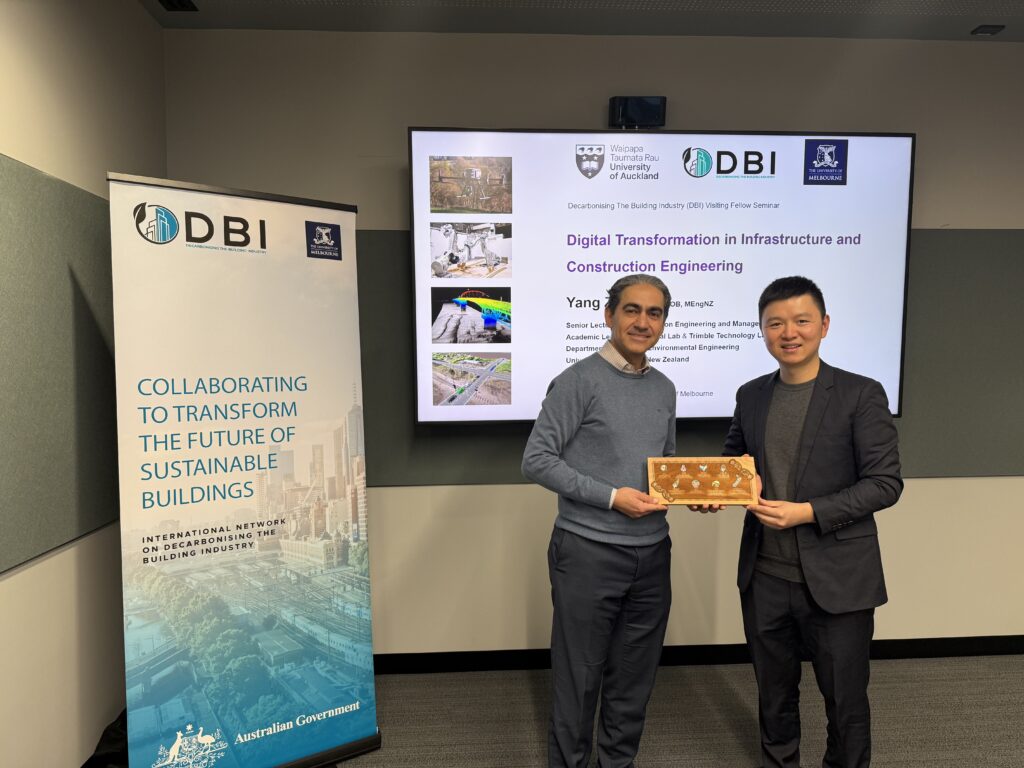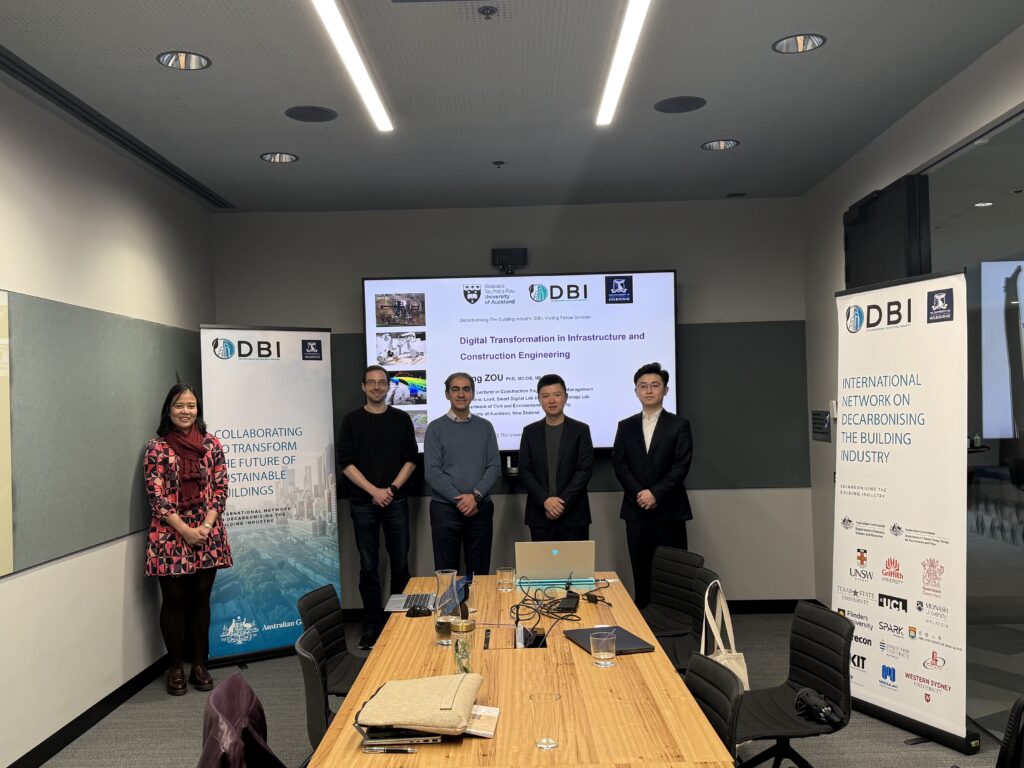On the 25th of August, the Decarbonising the Building Industry (DBI) initiative had the privilege of hosting Dr Yang Zou, senior lecturer in the Department of Civil and Environmental Engineering at the University of Auckland, as a visiting fellow. Dr Zou delivered a compelling presentation on digital transformation in infrastructure and construction engineering, offering a deep exploration of how emerging technologies can address critical challenges in the sector.

The state of the construction sector
Dr Zou began by highlighting the construction industry’s persistent struggles with productivity, safety, and cost overruns. Citing the International Labour Organization, he noted that the sector accounts for approximately 60,000 fatal incidents annually, representing one in six workplace deaths globally. In New Zealand, for example, 50-70% of transport agency projects exceed their budgets, with an average overrun of NZD 15 million. A McKinsey report further underscored that while manufacturing has nearly doubled its productivity over the past two decades, construction has remained stagnant, largely due to limited adoption of digital technologies.
Compared to highly digitised industries like ICT, media, and finance, construction ranks among the least digitised, alongside agriculture and hunting. However, Dr Zou pointed out that comprehensive adoption of digital technologies could reduce project costs by up to 55%. Aging infrastructure adds further complexity, with 10% of bridges in the United States labelled structurally deficient, requiring USD 12 billion annually for maintenance. Climate-driven natural disasters, such as earthquakes and floods, exacerbate these challenges, underscoring the need for smarter solutions.
The evolution of digital transformation
Dr Zou traced the history of digital transformation in construction, focusing on the pivotal role of building information modelling (BIM). From Ivan Sutherland’s groundbreaking work on computer graphics in 1963 to the introduction of AutoCAD in 1982 and the conceptualisation of BIM by Professor Chuck Eastman in 1974, the industry has gradually shifted from manual sketches to data-driven design. BIM allows buildings to be represented as 3D assemblies of Lego-like blocks, embedding critical information into each component. Modern advancements, such as open BIM standards (e.g., IFC) introduced in the 1990s, have addressed data exchange issues, enabling seamless collaboration across platforms.
The availability of digital data has unlocked new possibilities, from supporting 3D printing to integrating IoT sensors, robotics, and AI analytics. Since 2020, large language models (LLMs) have emerged as powerful tools, transforming how we interact with and extract value from data in construction.
Showcasing innovative research
Dr Zou shared two groundbreaking projects from his team at the University of Auckland, demonstrating the transformative potential of digital technologies.
1. AI-driven knowledge reuse
Led by his PhD student, Jen Jan, the first project focuses on using AI to extract and reuse engineering knowledge from past projects. Construction generates vast amounts of unstructured data – emails, PDFs, meeting notes, and BIM models – but much of the critical knowledge remains “below the waterline,” embedded in undocumented decisions and lessons. Dr Zou’s team employs retrieval-augmented generation (RAG) to combine structured (e.g., ontology models, JSON files) and unstructured data (e.g., PDFs) with LLMs to extract relevant insights in near real-time.
For example, in steel structure joint design, their system uses ontology models to enhance LLM reasoning, allowing designers to query past lessons and integrate them into new projects. The team envisions integrating this system as a plug-in for BIM software like Revit, streamlining the design process. Early evaluations show promising results, with the system effectively answering randomly generated questions about engineering scenarios.
2. Automated infrastructure inspection
The second project integrates drones, AI, and digital twins for automated infrastructure inspection and management. Dr Zou’s team has developed drones capable of autonomous data collection in GPS-denied environments, such as under bridges or indoors, using advanced navigation and localisation techniques. These drones carry sensors like RGB cameras, LiDAR, and thermal cameras to capture data, which is processed using photogrammetry to create 3D point cloud models.
AI algorithms then analyse these models to detect and quantify defects, such as cracks, and generate condition ratings or repair strategies. To address data scarcity, the team combines deep learning with engineering knowledge, treating point clouds like finite element models to improve segmentation accuracy. Additionally, they’ve developed adaptive inspection methods that adjust drone flight paths based on defect size and use dual-camera systems to map thermal images onto 3D models, creating detailed building envelopes.
Dr Zou also explored the use of virtual reality (VR) for remote inspections, allowing inspectors to assess infrastructure in a 3D environment. By analysing heatmaps of inspector focus areas, the team aims to standardise inspection processes and reduce errors, paving the way for human-robot collaborative systems.
Looking ahead, Dr Zou identified two key trends: digitalisation and automation. While AI and robotics hold immense potential, challenges remain. Data scarcity and quality are significant hurdles, as many local councils and agencies are reluctant to share data due to liability concerns. Cybersecurity, explainability of AI models, and the need for ethical education in engineering curricula are also critical issues. Moreover, the construction sector’s dynamic, large-scale, and unstructured environments pose unique challenges for automation compared to controlled settings like manufacturing.
Dr Zou emphasised that technologies must deliver clear engineering value to justify investment. For example, the UK’s National Highways roadmap to 2035 highlights how robotics and automation could boost the construction economy, but practical implementation requires addressing both technical and non-technical barriers.

Dr Yang Zou’s presentation offered a fascinating glimpse into the future of construction and infrastructure, where digital technologies like AI, robotics, and digital twins can enhance productivity, safety, and efficiency. His team’s innovative projects demonstrate practical applications of these tools, from reusing engineering knowledge to automating inspections. However, realising this potential requires overcoming data, ethical, and investment challenges.
We extend our heartfelt thanks to Dr Zou for sharing his expertise and sparking inspiration for future collaborations. His work aligns closely with DBI’s mission to advance sustainable practices in the building industry, and we look forward to exploring partnerships with the University of Auckland’s digital construction labs.

